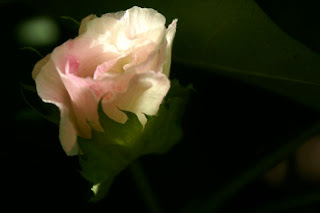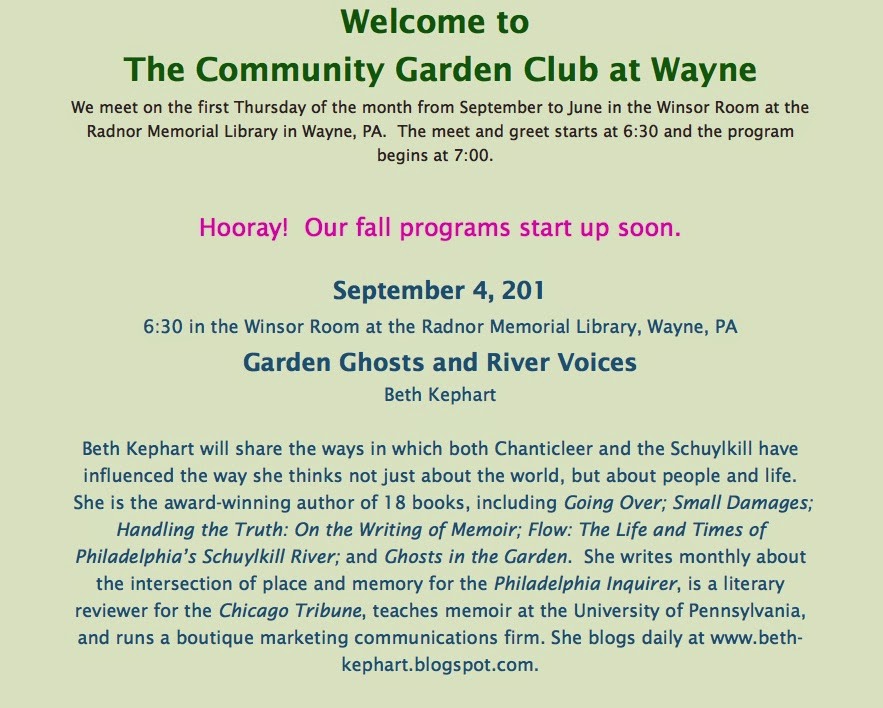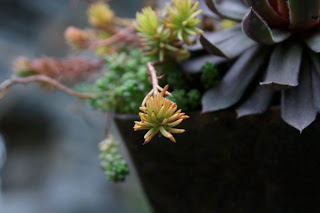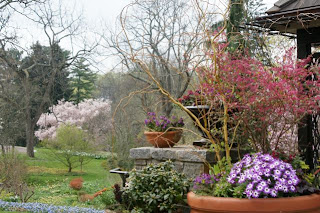new posts in all blogs
Viewing: Blog Posts Tagged with: GHOSTS IN THE GARDEN, Most Recent at Top [Help]
Results 1 - 16 of 16
How to use this Page
You are viewing the most recent posts tagged with the words: GHOSTS IN THE GARDEN in the JacketFlap blog reader. What is a tag? Think of a tag as a keyword or category label. Tags can both help you find posts on JacketFlap.com as well as provide an easy way for you to "remember" and classify posts for later recall. Try adding a tag yourself by clicking "Add a tag" below a post's header. Scroll down through the list of Recent Posts in the left column and click on a post title that sounds interesting. You can view all posts from a specific blog by clicking the Blog name in the right column, or you can click a 'More Posts from this Blog' link in any individual post.
It's been some time since I wrote that fifth memoir,
Ghosts in the Garden—a meditation on the two years I spent walking Chanticleer (in Wayne, PA). I was at a crossroads. Middle aged. Not sure. Pondering my purpose.
Published by New World Library, this slender book, about a well-loved but entirely local garden (every garden is an entirely local garden), went on to be reviewed in papers across the country (I could not have guessed that) and to be translated (this was an even bigger surprise) in South Korea. It sold out of its original modest printing of 5,000 copies and was never reprinted.
Done. Gone. Another Kephartian exercise, by most standards, in the small.
And yet. Every now and then the book returns to my life. This past week it did, in the form of this photograph—a South Korean garden lover who had read the translation in her country (she holds it in her left hand) and come here, to Wayne, PA, to find the garden with her husband.
A book brought a reader across the ocean to a garden.
What makes a book small? What makes a book big? I wish we never had to ask that question. I wish that we'd stop quantifying authors by sales or prizes and take solace in stories about individual readers who allowed a book to prompt a journey.
One book. One reader. One garden. One sunny day. One surprising photograph. Two smiles on two faces.
Thank you, BJ, for sending that smile my way.
One of my incurable obsessions is imagining Then. The yesterday years. The years before those. The land before it was cultivated. The earth before the glaciers peeled off. The mountains before they were sprung loose from the seas. The birds when they were the size of dinosaurs.
Give me an afternoon off, keep me on hold for a conference call, put me in the car alone for a long drive, and I’m thinking about Then. We live in a transitory and transitional time. We have entered, say some, the Epoch of the Anthropocene. We have reconstructed and redirected our planet to suit our own needs. Nothing that is here right now was here eons ago. And none of it will be here in the long future.
— excerpted from "Garden Ghosts and River Voices," the talk I'll be giving this evening as the Community Garden Club at Wayne kicks off its season. The
event is free and open to the public. Copies of
Flow: The Life and Times of Philadelphia's Schuylkill River (the affordable paperback edition), my Chanticleer memoir
Ghosts in the Garden (some of the final copies in existence), and my Chanticleer young adult novel
Nothing but Ghosts will be available.
The details:
September 4, 2014, 6:30 PM
Community Garden Club at Wayne
"Garden Ghosts and River Voices"
Nothing but Ghosts/Ghosts in the Garden/Flow
Open to the public
Winsor Room
Radnor Memorial Library
Radnor, PA
The talk is written.
The doors will be open.
Rivers. Gardens. Ghosts.
Radnor Memorial Library
September 4, 2014
A few days ago, I wrote of an
upcoming September 4 talk at Radnor Memorial Library, open to the public, about my ghosts (which is to say my two Chanticleer inspired books) and my river (
Flow).
Today I'm posting information for two keynote addresses I'll be giving in honor of the Schuylkill River Heritage Area's 2014 River of the Year Lecture series, on October 14 and 16. Details and registration for these free events are
here.
I hope you'll join us.
A few weeks ago, Peter Murphy, who presides over the Community Garden Club at Wayne, invited me to come and speak about those ghosts of mine—the Chanticleer memoir (
Ghosts in the Garden) and the Chanticleer young adult novel (
Nothing but Ghosts). After a brief flurry of emails we settled on the topic above—Garden Ghosts and River Voices—a talk I'm writing now and am eager to give.
This first-of-the-year program (September 4, 2014) is open to both the Garden Club and to anyone who wants to come. Copies of books will be on hand. For more on the Community Garden Club at Wayne, go
here.
Several weeks ago, Avery Rome of the
Philadelphia Inquirer got in touch with a question. Would I be interested in writing in occasional pieces for the paper's Currents section? Pieces about my intersection with my city and its fringes, perhaps. Pieces about the people I meet or the questions I have. Avery has been at work at the
Inquirer through many seasons—vital and invigorating, disciplined and rigorous, enriching the pages with literature and poetics, even, with different and differing points of view. If the
Inquirer has gone through many phases, it has always been clear on one thing: Avery Rome is indispensable.
Would I be interested? she'd asked.
Well, who would not be? I'd have reason to sit and talk with Avery, for one thing, which is a pleasure every time. And I would be joined in these pages by two incredibly special women, Karen Rile and Elizabeth Mosier. Both are first-rate teachers and mentors—Karen at Penn and Elizabeth at Bryn Mawr College. Both write sentences that thrill me, stories that impress. Both are mothers of children I love, children whose plays I have gone to, whose art I have worn, whose questions have made me think, whose inner beauty is as transparent as their outer gorgeousness. And both are very essential friends.
Karen and Elizabeth's zinging essays have already appeared in the
Inquirer and can be found
here and
here.
My piece appears today. It was commissioned and written during the high heat of last week, before the gentling rains of this weekend. It takes me back to Chanticleer, a garden that inspired two of my books (
Ghosts in the Garden, Nothing but Ghosts) and is a source of escape, still. The essay ends with these words and includes two of my photographs of small, sacred places at this gorgeous pleasure garden:
In the high heat of this summer I find myself again returning to Chanticleer — walking the garden alone or with friends. The sunflowers, gladiola, and hollyhocks are tall in the cutting garden. The water cascades (a clean sheet of cool) over the stone faces of the ruins and sits in a black hush in the sarcophagus. Bursts of color illuminate the dark shade of the Asian Woods. The creek runs thin but determined.
I don't know why I am forever surprised by all this. I don't know how it is that a garden I know so well — its hills, its people, its tendencies, its blocks of shade — continues to startle me, to teach me, to remind me about the sweet, cheap thrill of unbusyness, say, or the impossibility of perfect control. We do not commandeer nature — gardeners know this best of all. We are born of it, live with it, are destined for return.
Dust to dust, yes. But why not shade and blooms in between? Why not gardens in this summer of infernal, angry heat?
Wishing us all more rain, less heat, and the goodness of editors who love words, gardens that still grow, friendships that nurture, and children who move us on this Sunday morning.
I've worked with my artist husband on two previous books—
Ghosts in the Garden (New World Library) and
Zenobia: The Curious Book of Business (Berrett-Koehler). This past year, we've been collaborating on a third—
Dr. Radway's Sarsaparilla Resolvent, an illustrated teen novel that features Philadelphia's own Baldwin Locomotive Works, Eastern State Penitentiary, the great Schuylkill River, a blowzy named Pearl, and my hero George Childs, among other places and souls. It features, as well, the odd tonics and medicines of the time—the strange promises and possible powers of herbal concoctions and flowering vines. William of
Dangerous Neighbors fame stands at the center of this novel. Two twins waft through.
This morning, my husband has completed the design of the book's cover (he has also created nearly a dozen interior illustrations), and while I cannot unveil the whole, I am happy to share this small corner of an image that perfectly captures 1871 and, at the same time, suggests the story's very modern spirit.
I am ridiculously happy about all of this. Not just that the book will exist (spring 2013). But that my fictional William was rendered by my real-life William, and that a very kind press is giving both a home.
Dr. Radway's Sarsaparilla Resolvent, my 1871 prequel to
Dangerous Neighbors, will (I'm happy to report) be illustrated by my husband. That makes this book our third collaboration. Bill illustrated my co-authored corporate fairytale
Zenobia and took the majority of the photographs that appeared in my fifth memoir,
Ghosts in the Garden. He began early sketches for this project more than a year ago, with
this image. I am especially happy about this collaboration, for I have long been mapping
the rise of illustrated middle grade/YA books. This is a fragment of the image that will most likely grace the cover of the book. William, who was introduced in
Dangerous Neighbors as a boy who rescues lost animals for a living, is the star of this story. Early on in the story he decides to keep this unclaimed goat, whom he names Daisy and who travels with him on his varied adventures.
I can't wait to see this book come to life. I am especially eager to share it with Philadelphians who today walk the (much transformed) streets that William claims as his own.
We waited for rain a long time in these parts, and when it came, Chanticleer, the garden that has formed the backdrop of two of my books (
Ghosts in the Garden and
Nothing But Ghosts) was glorified.
These shots were stolen on Wednesday afternoon.
It's been many years now since I first stumbled onto Chanticleer, a pleasure garden ten minutes from my home. In the epics and eras since, Chanticleer has served as a retreat of sorts, become a place of friendship, and crept its way into two of my books (
Ghosts in the Garden (a memoir) and
Nothing but Ghosts (a YA novel)). It has also become a birthday tradition. The garden opens on April 1st of each year. I go to bear witness and to reflect on my own life.
Profoundly exhausted, I wasn't sure that I'd make it this year. I was glad I found a way. The skies were gray but not storming when I arrived. The daffodils and cherry trees had bloomed out early, as was this eager season's way. Still, purple and blue electrified the landscape. The neon koi were in their pond. The pots were brimming.
"Now I'm going to show you my favorite part," a little girl told her mother as she ran by. And then: "Oh, look! It's changed. It's even better!"
Change. Yes. It just keeps coming. That's the way it is, the way it will be. But I am grateful for the familiar rolling hills of Chanticleer, the familiar faces. I am grateful for the reflecting ponds that restore me, for the quiet that I find, because I'm searching.
A few posts back, I showcased
my $6.88 royalty check—a check received for my fifth memoiristic volume,
Ghosts in the Garden. Ghosts went out of print shortly before that check made its way to me, but it earned out anyway, thanks to a small sale in South Korea and the many fans of Chanticleer garden, where that book takes place.
Today I learned that
Flow, my autobiography of the Schuylkill River, has also earned out its small advance in an equally small, but meaningful way, and I'm taking this moment to honor that—to honor these books of ours that don't slot easily into any proven category, that don't have a logical spot on Barnes & Noble shelves, that don't scream Bestseller to those who dare to take them on, and that find their right readers nonetheless.
Flow is the book that most people laughed at before it was published, and
Flow is also the book that changed my place in Philadelphia, this city I love.
I hear more about
Flow than nearly any other book I've published. Not because it sold hugely—it didn't (though this one is still in print)—but because readers are smarter and more willing to stretch than many give them credit for. "I have no idea what this book is," Micah Kleit, Temple University Press editor, said to me, early on. "But we want to take the risk."
Thank you, Micah, Ann Marie Anderson, and Publicist Supreme Gary Kramer, for taking that risk with me, for giving me a book that I remain most proud of.
(And thanks, Karen Baker, for taking my call.)
the young man in the fifth row asked. I'm
always asked.
They want to know, these aspiring writers, if they can make a living at this crazy word stuff, and so we talk about what "living" is, about commercial books and literary ones, about big advances and zero advances, about being one's own best advocate and looking ahead to new books. "You write your book, you advocate for your book, and then you keep creating," I tell them. "A writer's primary job," I reiterate, is to keep dreaming and creating."
But what's a royalty check? they want to know. And when you get them, do you celebrate?
This, my dear readers, is one literary writer's royalty check. Not a whole lot, you say? But consider this: The book was written and the book was made. It contains a part of me, a stretch of days, that might otherwise have been forgotten.
 As those who read this blog know well, Nothing but Ghosts was written in the wake of my own mother's passing—inspired by the finch, the fox, and the songs that edged near to assure me that her spirit was yet within reach. Much of the book takes place in a fictionalized version of Chanticleer, the pleasure garden. In this photograph, the great katsura tree rises over a bench a gardener made, and those who sit there can look out over Doug's cutting garden and the wild profusion of asparagus. Beneath the shade of that katsura is a stone I asked an artist to create for me, a stone that Doug placed, just right, between the shade of limbs. The stone reads "the wedge of sun between us." It's a line from my memoir, Ghosts in the Garden, a line that memorializes my mother.
As those who read this blog know well, Nothing but Ghosts was written in the wake of my own mother's passing—inspired by the finch, the fox, and the songs that edged near to assure me that her spirit was yet within reach. Much of the book takes place in a fictionalized version of Chanticleer, the pleasure garden. In this photograph, the great katsura tree rises over a bench a gardener made, and those who sit there can look out over Doug's cutting garden and the wild profusion of asparagus. Beneath the shade of that katsura is a stone I asked an artist to create for me, a stone that Doug placed, just right, between the shade of limbs. The stone reads "the wedge of sun between us." It's a line from my memoir, Ghosts in the Garden, a line that memorializes my mother.
This morning, Shelf Elf let me know that she had posted a review of Ghosts. Her extraordinary words touched me deeply, for she had seen what it is that I try to do with books, writing in part, "Beth writes about the quiet miracles of real life. She helps readers to see that ordinary experience, all of it – the trouble and sadness and simple day-to-day joy of it – is worth noticing." I know this isn't always an approach that resonates with readers; it is, however, what I have chosen to do in this book life of mine, and I am so grateful, always, when touched by the grace of readers who wait, who read, who imagine themselves inside these worlds.
 Kelsey Coons is family—the daughter of my cousin, Linda, and thus a Kephart by blood. Like her sister, Brianne, she is athletic, gorgeous, smart. Like her sister, she had a knack for making my mother smile. She always makes me smile, too, especially since we're also united by our love for dance (and for the show, So You Think You Can Dance).
Kelsey Coons is family—the daughter of my cousin, Linda, and thus a Kephart by blood. Like her sister, Brianne, she is athletic, gorgeous, smart. Like her sister, she had a knack for making my mother smile. She always makes me smile, too, especially since we're also united by our love for dance (and for the show, So You Think You Can Dance).
Last fall Kelsey took a college class called Rhetoric of Style and chose the chapter "A Talent for Living" from my memoir Ghosts in the Garden as the subject of her final paper. Yesterday she asked if I would like to read it, and of course I said I would. I wanted to know Kelsey better. As it turns out, she taught me a whole lot about myself. About how I use semi-colons (as fulcrums). About how my use of the rhetorical I and you allows me to "generalize (my) personal epiphany to apply to reader who may make their living other ways." About how I use parentheses to validate word choices. About the emphasis I place on sounds. About the chemical mix of my choice in pronouns.
It is stunning to come up against the thoughts of one who has counted, literally, the syllables in your sentences, who has weighed the anaphoric series, who has discovered the rationale behind your own word choices, and not just your word choices, but your vowel choices. It is, in fact, humbling, to be found out—to have what you thought were your secrets parsed. On every level of her assessment, Kelsey got this right. She saw what it was that I hoped to do with words, and word parts, and expressed it far more intelligently than I myself would know how to do.
This blog post, then, is to honor Kelsey, and her talent for paying such close attention.
 It was my friend Buzz Bissinger who got me onto Facebook—a series of notes from him that could not be read unless I went ahead and plugged myself in. I'm not what anyone would call Facebook adept; I still can't figure out which notes are private, which are public, what the world sees and what gets sent to just one friend. And don't even ask me about that wall, and to be honest: the photos that I've posted are just the ones that have stuck; who knows where the rest of them have gone to.
It was my friend Buzz Bissinger who got me onto Facebook—a series of notes from him that could not be read unless I went ahead and plugged myself in. I'm not what anyone would call Facebook adept; I still can't figure out which notes are private, which are public, what the world sees and what gets sent to just one friend. And don't even ask me about that wall, and to be honest: the photos that I've posted are just the ones that have stuck; who knows where the rest of them have gone to.
Still and nonetheless (and yet!): Facebook has brought me back into touch with former high school track teamers (Donna and Donna) and with a Bread Loaf alum (Leslie Pietrzyk). It has introduced me to editors and readers. It has kept me up-to-date with the infamous personalities of the ballroom dance world (the famous ones, too), and it has presented me with a number, an actual number, of friends. Counted them up for me on the off-chance that I need to quantify my life. (According to the stats, I have far fewer "friends" than the average Facebooker.)
This week, I received a message, and then a brief series of notes, from a writer named Kathy Briccetti. Ultimately I received from her an attachment. It was an essay she'd written for an anthology called A Cup of Comfort for Writers. The piece is called "The Drowning Girl." It recounts a moment several years ago in the Tiburon bookstore, Book Passages, where I'd gone to read from my Chanticleer memoir, Ghosts in the Garden, and where I talked about the writing life. Kathy had been in the audience that night. She captured that moment in time.
I am no celebrity writer. I rarely read from my own books. I've only ever once been invited to the BEA, and this is what happened then: They put my signing "line" directly beside Jodi Picoult's signing line. Guess which line was longest (by about ten miles)? And so it touched me more deeply than I can say to read Kathy's account of an evening four years ago, to realize that I'd been listened to that carefully, that I'd been transcribed onto another's page. I don't believe I've ever read another's account of me; it's one thing to be interviewed and it's another to be described. My wild hair is there. My deep set eyes, lost entirely to shadow. My way of speaking, pausing, thinking.
What is the punch line? What is there to say? Nothing, but that I found myself in tears by the essay's end. That was me then. I existed.
 I write the elements, I said. Earth. Air. Fire. Water. I imagine myself gone, within them. The river as a woman. The fire as a man. The earth cracked open, so many mouths through which to speak.
I write the elements, I said. Earth. Air. Fire. Water. I imagine myself gone, within them. The river as a woman. The fire as a man. The earth cracked open, so many mouths through which to speak.
And air?
And air is wind. And air is weather. A character—changeable, present.






























I love this. Thank you for sharing Chanticleer with me and letting me sit and look out at all that green. As you know, I spend every single day in this city looking for more green :) I think you're right that it helps you begin.
I can't wait to read your piece! What a week it's been for you! xoxo
Wonderful. I will read the piece now.
Hi, Beth--
I enjoyed your piece. I am also one of the columnists Avery recruited. My first column appeared last week. Kudos on your Inky debut. --Kelly McQuain
Of course, this piece thrills me! I can't wait to meet Chanticleer, up close and personal - in September.
Thanks for Sharing (your joy and your words for) this special place!